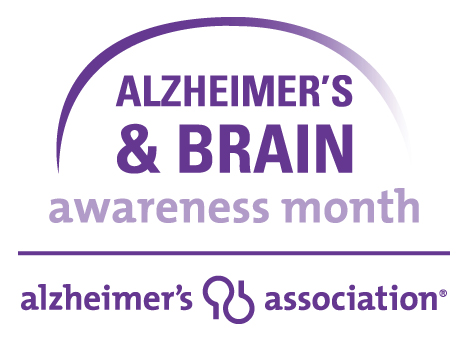| It’s Alzheimer’s and Brain Awareness Month
 This June is the inaugural Alzheimer’s & Brain Awareness Month – an opportunity to hold a global conversation about the brain, Alzheimer’s disease, and other dementias. Worldwide, an estimated 44 million people are living with Alzheimer’s and dementia, and everyone who has a brain is at risk. Alzheimer’s & Brain Awareness Month is the perfect opportunity for the public health community to take action on this growing public health crisis. This June is the inaugural Alzheimer’s & Brain Awareness Month – an opportunity to hold a global conversation about the brain, Alzheimer’s disease, and other dementias. Worldwide, an estimated 44 million people are living with Alzheimer’s and dementia, and everyone who has a brain is at risk. Alzheimer’s & Brain Awareness Month is the perfect opportunity for the public health community to take action on this growing public health crisis.
You can start with something simple: on Friday, June 20, and Saturday, June 21, wear purple – the official color of the Alzheimer’s movement. For substantive actions, public health officials can turn to the Public Health Road Map on cognitive health and Alzheimer’s disease, released by the Alzheimer’s Association and the Centers for Disease Control and Prevention (CDC). This Road Map contains numerous activities that could be done during Alzheimer’s & Brain Awareness Month, including:
•Posting links on public health web sites to local, state, and national resources on dementia, including those specific to Alzheimer’s disease and caregiving, such as www.alzheimers.gov and http://www.cdc.gov/aging/aginginfo/alzheimers.htm (Road Map action item E-03).
•Promoting local participation in clinical trials and studies on cognitive health and impairment (E-08).
•Educating health care providers about validated cognitive assessment tools that could be administered in a variety of medical settings (W-06).
•Increase awareness among healthcare professionals about care partner health (W-07).
For more information about Alzheimer’s & Brain Awareness Month, including how you can get involved, visit alz.org/abam.
Healthy People 2020 Webinar to Focus on Alzheimer’s and Dementia Objectives
 On Thursday, June 19, from 12:30 to 2:00 Eastern time, the federal government will hold a public webinar on the Alzheimer’s and dementia objectives of Healthy People 2020. Speakers will include Wayne Giles, Director of the Division of Population Health at the Centers for Disease Control and Prevention; Marie Bernard, Deputy Director of the National Institute on Aging; and Edwin Walker, the Deputy Assistant Secretary for Aging at the Administration on Aging. On Thursday, June 19, from 12:30 to 2:00 Eastern time, the federal government will hold a public webinar on the Alzheimer’s and dementia objectives of Healthy People 2020. Speakers will include Wayne Giles, Director of the Division of Population Health at the Centers for Disease Control and Prevention; Marie Bernard, Deputy Director of the National Institute on Aging; and Edwin Walker, the Deputy Assistant Secretary for Aging at the Administration on Aging.
For the first time ever, “Dementias, including Alzheimer’s” was included as a topic area in the federal government’s Healthy People plan, with objectives on increasing the number of people who are aware of their dementia diagnosis and on decreasing the number of preventable hospitalizations among people with dementia. This webinar comes on the heels of the release of baseline measures for the dementia objectives, which showed that only about one-third of seniors with a dementia diagnosis are aware of the diagnosis and that over a three year period, one quarter of those with a dementia diagnosis had a preventable hospitalization.
To join the webinar, please register here.
New study explores link between physical activity and cognitive decline
A new study provides further evidence that physical activity may protect against cognitive decline. Researchers followed four groups of older adults who were categorized by physical activity levels and genetic risk of developing Alzheimer’s disease (based on the presence or absence of the APoE-4 allele, a known genetic risk factor). After 18 months, researchers found hippocampal atrophy only in those who had both low physical activity levels and high genetic risk. Because the hippocampus – the area of the brain responsible for memory and spatial orientation – is often the first area affected by cognitive decline, researchers believe their findings suggest physical activity may help to maintain hippocampal volume in those at high genetic risk of developing Alzheimer’s.
While more research is needed to identify the level and amount of physical activity that may help protect against cognitive decline, public health officials should work to integrate cognitive health messages into existing efforts to promote physical activity. More information on the link between physical activity and cognitive health, including a short video, is available here.
The Alzheimer’s Public Health E-News is supported by Cooperative Agreement #5U58DP002945-04 from the Centers for Disease Control and Prevention (CDC). Its contents are solely the responsibility of the Alzheimer’s Association and do not necessarily represent the official views of the CDC.
|